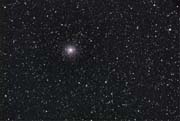Shortly before my holiday, a marvellous image of NGC 5907 in Draco was published on the internet by R. Jay Gabany, showing beautiful tidal streams of stars spiralling out from the galaxy. Under the expected pristine skies of La Palma, I hoped to capture these, but it was not to be. This is a mediocre monochrome image of the galaxy. Maybe another time....
(See my Artemis page for a decent colour version, but no sign of the tidal streams)
Despite the hazy skies during the first week, the magic of narrow band filtering enabled me to capture this Hydrogen alpha image of Messier 16. But no colour information - dawn approached before I could complete the series, and I never returned.
Abell 2151 is a cluster of faint galaxies in Hercules. Also therefore known as the Hercules Galaxy Cluster! A bit more successful than some of the other images, binned 2x2 to capture the faint galaxies in the limited time of clear spells, so the link from the thumbnail is the full size image.
Messier 27 in Vulpecula is of course a well known target, and I have a good colour image of it here.
But again I hoped that the skies of La Palma would enable me to capture the faint outer shell of this beautiful planetary nebula. And again I was thwarted by the conditions, although a hint of it is visible in this monochrome Hydrogen alpha crop from a 2x2 binned sequence.
Several of the Messier globular clusters are low down in the sky from my 55 degree north latitude, so I hoped to rectify the situation while on La Palma. But only two were captured. First Messier 54 in Sagittarius, at -30 Declination, only 5 degrees above my home horizon at its highest.
Then Messier 62 in Ophiucus. Also - 30 degrees Declination.
The only other vaguely astronomical photo was a wide field evening shot of a waxing Moon taken with my Panasonic TZ5 digital camera. Taken on 4th July, when the planets Saturn and Mars, and the bright star Regulus formed a straight line in the Western Sky. Saturn at the top, then Mars then Regulus. The other star visible near the group is Algieba.






